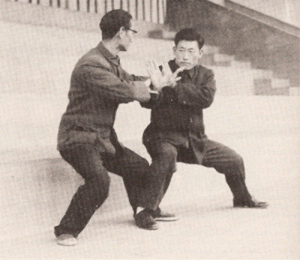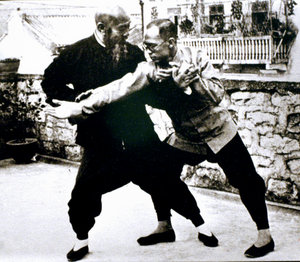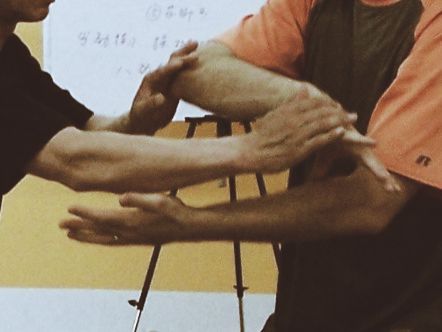Tai chi practitioners often ask what they should be working on to improve their tai chi. Typical answers to these types of questions vary based on a person’s experience and goals. However, there is one thing that I have seen that not only moves a student forward in their progress but makes them practice more because it adds an element of fun, at that’s by starting push hands. When students are pushing hands, they are trying out all the concepts they have learned. They are testing their posture and balance to make sure it is correct. And, they are interacting in a fun way with other classmates.
Push hands is a two-person martial arts routine that increases a student’s understanding of correct posture and alignment, use of internal and external strength, stepping, weight shifts, balance, and fighting applications. Push hands can be fixed sets of movements, involve stepping, and at the higher levels are free form competitions. Opponents work to make the other person step or fall.
Tai chi chuan push hands is one of the most misunderstood concepts of tai chi. Some think of it as slightly controlled sparring and some think it is very dance-like. For that reason, it scares off practitioners who may not see the relationship between pushing hands and their goals. If you are not martially focused, please read on because there are amazing benefits to doing push hands that are not related to fighting. And if you are martially focused, also read on! Pushing hands is hugely important for the development of internal skills, health, and martial application. We explained why tai chi applications do work as fighting techniques but know that push hands is the primary place to practice them.
To know yourself, practice the form. To know others, push hands.
Unknown
Why do tai chi push hands?
Let’s start with 6 huge advantages you receive basically from standing in front of someone and rocking back and forth. You gain an understanding of the body mechanics of the art.
- Push hands improves posture
- It explains why a posture from the form is a certain way. You may not be exactly sure where a hand goes in a posture but when you learn the application it is cemented in your brain. And posture is one of the primary focuses of any tai chi form.
- Push hands teaches the four main energies
- Listening (Ting)
- Understanding (Dong)
- Neutralizing (Hua)
- Issuing (Fa)
- You begin to understand the four main skills in making contact
- Connect (Lian) continually connecting physically and paying attention to intention.
- Follow (Sui) obeying your opponent’s intention by letting him think he can apply an application which leads him to use force.
- Stick (Nian) making light contact with an opponent without breaking.
- Adhere (Zhan) getting an opponent to follow you under your control.
- Pushing hands is a way to practice the four primary principles of movement
- Ward Off (Peng)
- Roll Back (Lu)
- Press Forward (Gi)
- Press Downward (An)
- Push hands also teaches the four secondary principles when doing the Da Lu Push hands form:
- Pluck (Cai)
- Split (Lieh)
- Elbow (Jo)
- Shoulder (Kow)
- It teaches how to move in the five main directions:
- Forward
- Backward
- Left
- Right
- Central Equilibrium
So I get all of this from standing in front of someone and pushing on them? Yes, in effect. Think of the amount of academic work that it would take to understand the above concepts. You can get their much faster just by beginning pushing hands. So I get all of this from standing in front of someone and pushing on them?
The above list may appear daunting but you can gain these skills from proper pushing hands without even knowing the concepts above exist. The martial implications are also more obvious when you are working with a partner. Let’s dive into the variety of pushing hands and help you identify how to let push hands address your goals.
What is Push Hands and What Are the Common Drills?

Tai chi push hands drills (tui shou or tai shou) start out simple and grow more complex. This is the same process for whether your main interest is martial or health or both. The difference is that the health-focused practitioner focuses on following and paying attention to the partner, breathing, posture, and balance. This starts with simple movements with the arms while the feet remain stationary. It grows in complexity and has moving sequences that almost look like a dance.
The martially minded pursue sparring routines, fighting, and unrehearsed sparring routines. Martially focused please note! You have to increase your sensitivity and move without using your muscle or you will not advance. You will just be doing a muscle exercise. Take your time and you will be hugely more effective and stronger.
It’s very hand to verbally describe pushing hands so let’s go the easy and fun route and look at some video clips.
One Handed Push hands Routine (Best example: 00:53)
Stationary Two-handed Pushing Hands (Best example: 01:57)
Moving Pushhands Patterns (Best example: 04:00)
Basic Pushhands Applications (Best example: 03:16) Example:
Tai Chi Push Hands Competition – Sparring
Tips to Improve Your Tai Chi Pushing Hands
I wanted to share some of my notes from push hands workshops because they have turned into some guiding principles which make people’s posture, movements, and learning progress more quickly.
- Look over the opponents shoulder. This keeps your posture upright.
- Don’t let your rear knee point to the ground. Sit more and have it point out in alignment with the toe. This stops your rear leg from locking (bracing).
- Keep space in your armpits. This keeps the blood flowing into your arms, your arms full, and stops your arms from being trapped against the body. In this picture where I am doing chen style tai chi pushing hands with Grand Master Chen Youze, you can see him instructing me to keep space in my armpit and roll to the side rather than having my arm pinned against my body.
- Rotate your knees in small circles rather than rocking forward and backward. When pushing hands correctly, the body sways in a figure-8 motion.
- Keep your elbows low and typically pointed towards the floor. This relaxes the shoulders and stops them from rising.
I find these tips to be constructive and helpful rather than saying “don’t brace your leg” or “don’t lean over.” It’s easier to learn what TO DO rather than what NOT to do.
How do I find a tai chi push hands group?
Finding a good tai chi push hands training group is often harder than learning the drills. Many practitioners that I know actually started their own groups as informal meet-ups. It’s important to find or form a group based on your goals. It is important to set the rules about what you are trying to accomplish otherwise attendees can get frustrated if they were expecting to work on form and find out that their partner wants to work on the fighting. Here are some tips for rules that we have established with our pushing hands groups:
- Rotate partners frequently so no one is stuck with the same person for a long time. This gives everyone a chance to work with people at different levels.
- Talk about the rules before anyone begins. Just like playing a game on the playground as a kid, we need to know what the rules are. The two important rules are 1) can the feet move and 2) can you push against the body. For this second one, we always and only push a person if we are pushing on their arm against the body rather than just pushing against the body itself.
- Start by everyone practicing the same tai chi push hands exercises and then you can break into ability groups or divide into those who want to work on the movements and those that want to work on the martial applications.
Keep Learning: What Does Tai Chi Mean? Definition, Spelling, and Pronunciation





Very helpful explanation / description. I was hoping to view the videos but they are all “private”. Thought you might want to know in case it’s a mistake.
You are right. They pulled those videos. I added some new ones. In the future in case the videos are removed you can just google each title (e.g. Tai chi pushhands application) and get a bunch of examples. Thank you for letting me know.